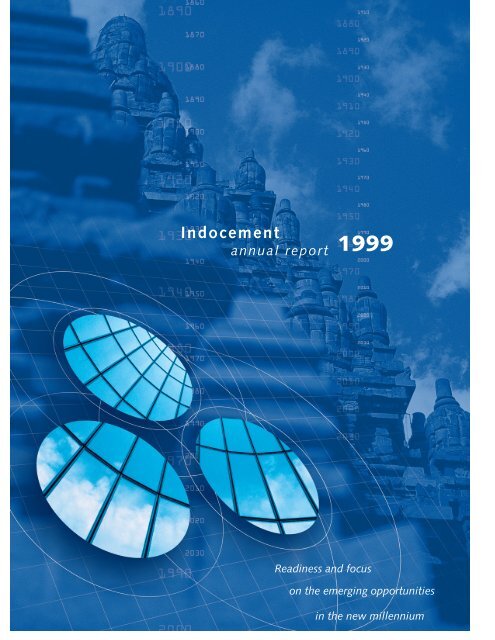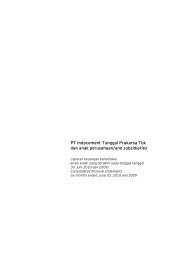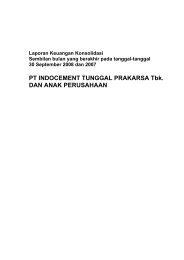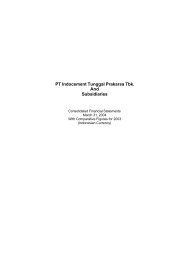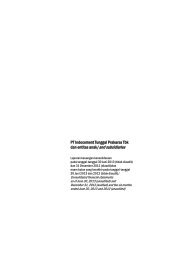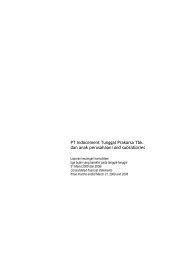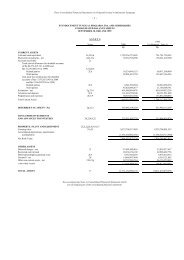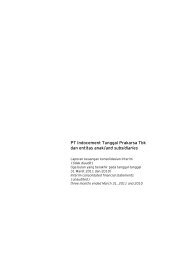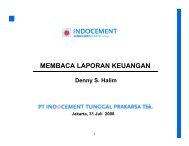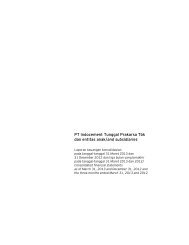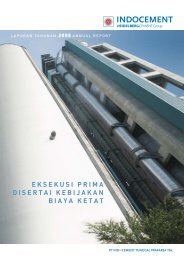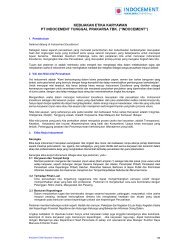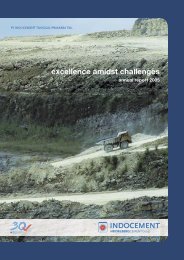Indocement Tunggal Prakarsa, PT.
Indocement Tunggal Prakarsa, PT.
Indocement Tunggal Prakarsa, PT.
You also want an ePaper? Increase the reach of your titles
YUMPU automatically turns print PDFs into web optimized ePapers that Google loves.
<strong>Indocement</strong><br />
annual report 1999<br />
Readiness and focus<br />
on the emerging opportunities<br />
in the new millennium
Contents<br />
02 Our Mission<br />
03 Consolidated Financial Highlights<br />
04 Corporate Structure<br />
05 About the Company<br />
06 Message from the Chairman<br />
08 The Board of Commissioners<br />
11 Report to Shareholders<br />
16 The Board of Directors<br />
Review of Operations<br />
18 Marketing<br />
21 Production<br />
23 A Brief History<br />
Financial Review<br />
25 Management’s Discussion and Analysis<br />
28 Human Resources<br />
30 Environment and Community<br />
33 Other Investments<br />
34 Five Year Summary<br />
35 Stock Market Performance<br />
36 Independent Auditors’ Report<br />
80 Corporate Information
Our Mission<br />
Leadership in cement and associated core businesses<br />
• providing superior returns to shareholders, and<br />
• contributing to Indonesia's economic development.<br />
Good corporate citizenship<br />
• providing continuing opportunities for employees’ success<br />
and growth,<br />
• supporting community and environment development, and<br />
• providing opportunities for the public to participate and<br />
share in the Company's success.
Consolidated Financial Highlights<br />
Amounts in billions of<br />
Rupiah unless otherwise stated 1999 1998 % Change<br />
Restated<br />
Net revenues 1,759 1,590 11<br />
Income from operations 371 437 (15)<br />
Income (loss) before income tax 757 (1,082) 170<br />
EBITDA 1,164 (546) 313<br />
Net income (loss) 523 (634) 182<br />
Earnings (loss) per share (Rp) 217 (263) 182<br />
Net cash provided by operating activities 923 564 64<br />
Capital expenditures 189 1,783 (89)<br />
Total assets 9,851 9,641 2<br />
Net indebtedness 7,362 8,337 (12)<br />
Total shareholders’ equity 1,126 665 69<br />
Market capitalization as of 31 December 7,485 7,666 (2)<br />
Foreign exchange gain/(loss) 527 (1,082) 149<br />
Financial ratios (%)<br />
Net gearing 530 1,131 (53)<br />
Interest cover (times) 4.0 (1.8) 318<br />
I N D O C E M E N T A N N U A L R E P O R T 1 9 9 9 C o n s o l i d a t e d F i n a n c i a l H i g h l i g h t s<br />
03<br />
Debt to equity 505 805 (37)<br />
Return on equity 47 (95) 149
Corporate Structure<br />
<strong>PT</strong> INDOCEMENT TUNGGAL PRAKARSA Tbk.<br />
CEMENT BUSINESS<br />
Cement Manufacturing<br />
<strong>PT</strong> <strong>Indocement</strong> <strong>Tunggal</strong> <strong>Prakarsa</strong> Tbk. 100.0%<br />
Citeureup – 9 Plants<br />
<strong>PT</strong> <strong>Indocement</strong> <strong>Tunggal</strong> <strong>Prakarsa</strong> Tbk. 100.0%<br />
Cirebon – 2 Plants<br />
<strong>PT</strong> Indo Kodeco Cement 72.1%<br />
(Thru <strong>PT</strong> <strong>Indocement</strong> Investama)<br />
South Kalimantan – 1 Plant<br />
Others<br />
<strong>PT</strong> Indomix Perkasa 100.0%<br />
Ready Mix Concrete<br />
<strong>PT</strong> Indo Clean Set Cement 47.5%<br />
Clean Set Cement<br />
<strong>PT</strong> Dian Abadi Perkasa 51.0%<br />
Cement Trading<br />
OTHER INVESTMENTS<br />
Offices & Hotels<br />
<strong>PT</strong> Wisma Nusantara International 33.9%<br />
Wisma Indosemen 100.0%<br />
Industrial Estates<br />
<strong>PT</strong> Cibinong Center Industrial Estate 50.0%<br />
Engineering Services<br />
<strong>PT</strong> Indotek Engico 50.0%<br />
Allied Businesses<br />
<strong>PT</strong> Indominco Mandiri 35.0%<br />
Stillwater Shipping Corporation 50.0%
About the Company<br />
The Company is one of Indonesia's premier producers<br />
of quality cement and specialty cement products. The<br />
Company has grown from a small cement plant with an<br />
annual production capacity of 0.5 million tons in 1975<br />
to a fully-integrated cement manufacturing enterprise<br />
with a total production capacity today of more than<br />
15 million tons clinker per year.<br />
The Company is listed on the Jakarta and Surabaya<br />
stock exchanges and had an annual sales revenue of<br />
approximately Rp1.8 trillion (US $ 248 million) in 1999.<br />
As a Group, the Company maintains major investments<br />
in fully-owned or controlled subsidiaries engaged in<br />
allied businesses such as coal mining, cement trading,<br />
I N D O C E M E N T A N N U A L R E P O R T 1 9 9 9 A b o u t t h e C o m p a n y<br />
05<br />
shipping, property, and technical services.<br />
At the end of 1999 the Group’s workforce numbered<br />
over 7,000 employees.
I N D O C E M E N T A N N U A L R E P O R T 1 9 9 9 M e s s a g e f r o m t h e C h a i r m a n<br />
06<br />
Message from the Chairman<br />
Board of Commissioners<br />
The race to take the lead in tapping the emerging opportunities in<br />
the new millennium has already begun<br />
1999 was a year of mixed challenges and a year of transition.<br />
The crisis in the Indonesian economy and across Asia continued to<br />
stall levels of activity in the construction sector. This undermined<br />
our earnings as domestic demand for cement remains down and<br />
export market continues to be highly competitive pushing export<br />
price to rock-bottom levels.<br />
On the other hand, although real economic impact is yet to be felt,<br />
the favorable developments in the Indonesian political situation<br />
starting with the successful democratic presidential election in June<br />
have deterred a further plunge in the Indonesian economy.<br />
The rupiah exchange rate has slightly improved and stabilized,<br />
interest rates have gone down, inflation has scaled down and<br />
indications of increasing economic activities started to appear by the<br />
latter half of the year. A similar trend is true in the Asian region<br />
where most of our export customers are based and where a number<br />
of our competitors operate. All these mark the transition in 1999<br />
from a period of uncertainties to a period of hope for the cement<br />
industry. Now, the race to take the lead in tapping the emerging<br />
opportunities in the new millennium has begun. We will stay focused<br />
and ready to perform despite the economic difficulties.<br />
Our strategic purpose is clear: We will sharpen our focus on<br />
emerging opportunities, and forge ahead to establish solid<br />
foundations for optimum returns for the Company<br />
For the Company’s part, the initiatives we took and the on-going<br />
programs we have implemented, tempered the effect of the crisis as<br />
we passed through very difficult times. The significant stride we<br />
made and which we are about to complete toward the successful restructuring<br />
of our loans and the positive inroads to forge alliances<br />
with strategic investors shall, in time, transform your Company’s<br />
position from uncertain to confident. Now, our strategic purpose is<br />
clear: We will sharpen our focus on the emerging opportunities, and<br />
forge ahead to establish solid foundations for optimum returns for<br />
the Company.<br />
Our principal challenges remain in optimizing sales, enhancing<br />
distribution, improving productivity and efficiency, and lowering
operating costs in order to regain competitive strength. With new<br />
technologies that improve quality and increase productivity,<br />
competence development is an increasingly important factor.<br />
Ongoing developments in our business organization and human<br />
resources are targeted to ensure that a large number of specialized<br />
skills combine effectively to achieve established goals.<br />
With our core competencies anchored on our state-of-the-art<br />
production facilities, highly committed work force and efficient<br />
supporting infrastructure, I am confident of the continued success of<br />
the Company as in past years. It may take some time before we are<br />
back to the level of profitability and sustained growth we had prior to<br />
the crisis, but the course has been set and positive indications are in<br />
line with our objectives.<br />
We remain confident that the Indonesian economy will continue to<br />
propel stability and improvement in business conditions as sound<br />
macro-economic fundamentals are eventually put in place.<br />
Management and staff continue to work together as an effective team<br />
focused on the Company's strategic aims and tackling today's<br />
challenges with greater dedication and vigor. Together with the<br />
continuing support of our valued customers, suppliers, bankers and<br />
of our shareholders, your Company is ready to march onward to the<br />
new millennium with greater determination to succeed.<br />
As we passed another eventful year, we grieve the demise of<br />
Mr. H. Aang Kunaefi, our colleague on the Board of Commissioners.<br />
We treasure his wisdom, his zeal and dedication to the Company.<br />
We heartily welcome Mr. I Ketut Mardjana, a new member of the<br />
Board of Commissioners.<br />
I N D O C E M E N T A N N U A L R E P O R T 1 9 9 9 M e s s a g e f r o m t h e C h a i r m a n<br />
07<br />
In closing, we extend our deepest appreciation to all our employees<br />
for their hard work and commitment throughout the year. We thank<br />
our valued customers, suppliers, bankers, and shareholders for your<br />
continuing support, faith and confidence.<br />
Soedono Salim<br />
President Commissioner
Sutanto Djuhar<br />
Johny Djuhar<br />
Soedono Salim<br />
I N D O C E M E N T A N N U A L R E P O R T 1 9 9 9 T h e B o a r d o f C o m m i s s i o n e r s<br />
08<br />
I Ketut Mardjana<br />
Tanto Koeswanto<br />
Andree Halim<br />
The Board of Commissioners<br />
The Board of Commissioners is responsible for overseeing the<br />
activities of the Board of Directors. Commissioners may examine the<br />
Company’s books, records and documents and have the power to<br />
temporarily suspend any Director in case of breach of the Articles of<br />
Association, neglect of his obligations, or failure to act in the best<br />
interest of the Company. Approval by at least three Commissioners is<br />
required for actions taken on behalf of the Company including<br />
borrowing money, granting guarantees, acquiring or disposing of<br />
fixed assets, and establishing subsidiaries.<br />
Kuntara
Soedono Salim, 83<br />
President Commissioner<br />
Mr. Salim has been President Commissioner of <strong>Indocement</strong> since 1985.<br />
He is one of the Company founders, as well as founder and Chairman<br />
of the Salim Group. He is also a Commissioner of several related<br />
companies. He was awarded the Dean’s Medal by the University of<br />
Pennsylvania’s Wharton School of Finance in 1996.<br />
Sutanto Djuhar, 71<br />
Commissioner<br />
Mr. Djuhar has been a Commissioner of <strong>Indocement</strong> since 1985 and<br />
was one of its founders. He is a business partner of Mr. Soedono Salim.<br />
Johny Djuhar, 41<br />
Commissioner<br />
Mr. Djuhar, a son of Mr. Sutanto Djuhar, has been a Commissioner of<br />
<strong>Indocement</strong> since 1993.<br />
Kuntara, 60<br />
Commissioner<br />
Mr. Kuntara has been a Commissioner of <strong>Indocement</strong> since 1994.<br />
Andree Halim, 52<br />
Commissioner<br />
Mr. Halim, a son of Mr. Soedono Salim, has been a Commissioner of<br />
<strong>Indocement</strong> since 1995. He is Vice Chairman of the Salim Group.<br />
Tanto Koeswanto, 59<br />
Commissioner<br />
Mr. Koeswanto was appointed as a Commissioner of <strong>Indocement</strong> in<br />
June 1997.<br />
I Ketut Mardjana, 49<br />
Commissioner<br />
Mr. Mardjana was appointed as a Commissioner of <strong>Indocement</strong> in<br />
August 1999. He received his PhD degree from Monash University,<br />
Melbourne, Australia.<br />
I N D O C E M E N T A N N U A L R E P O R T 1 9 9 9 T h e B o a r d o f C o m m i s s i o n e r s<br />
09
Report to Shareholders<br />
• Consolidated net income before tax turned around to<br />
Rp757 billion from a net loss of Rp1,082 billion in 1998.<br />
• Cash flow provided by the operations amounted to Rp923<br />
billion, 1.6 times last year’s figure of Rp564 billion.<br />
• Export sales rose by 80 percent to 2.2 million tons,<br />
providing cash generation of US$39 million.<br />
Dear Shareholders,<br />
This year marked a significant transition for your Company from the<br />
harsh realities of the Asian economic crisis.<br />
Consolidated net income before income tax turned around to Rp757<br />
billion from a net loss of Rp1,082 billion in 1998. This was brought<br />
about mainly by foreign exchange gain arising from the restatement<br />
of foreign denominated loans using an end-of-the-year middle rate of<br />
Rp7,100 per one US dollar compared to Rp8,025 applied at the end<br />
of last year.<br />
Consolidated gross profit rose 3 percent to Rp635 billion compared<br />
to Rp616 billion in 1998. However, consolidated income from<br />
operations dropped 15 percent to Rp371 billion from Rp437 billion<br />
last year .<br />
Cash flow provided by operations amounted to Rp923 billion,<br />
an improvement of Rp359 billion compared to the previous year.<br />
The return on equity, rebounded to positive 47 percent from a<br />
negative of 95 percent.<br />
I N D O C E M E N T A N N U A L R E P O R T 1 9 9 9 R e p o r t t o S h a r e h o l d e r s<br />
11<br />
OPERATING HIGHLIGHTS<br />
Export sales volume nearly doubled the previous year's level as<br />
successful market penetration strategies made inroads to additional<br />
markets in Asia, Africa and the Middle East.<br />
Recognizing that the marketing of our cement both locally and<br />
abroad requires continuing improvement and would necessitate<br />
significant effort and commitment, we have started the restructuring<br />
of our marketing organization to be able to concentrate more<br />
on development and sales, as well as a strengthened presence in<br />
both markets.
I N D O C E M E N T A N N U A L R E P O R T 1 9 9 9 R e p o r t t o S h a r e h o l d e r s<br />
12<br />
The average selling price for both domestic and export sales during the<br />
year rose to Rp250,685 per ton of cement from Rp211,860 last year<br />
brought about mainly by gradual adjustments in the price of cement in<br />
the domestic market. Total sales volume for the year was 8.6 million<br />
tons, 13 percent higher than last year.<br />
As dictated by market demand, production capacity utilization<br />
remained low at 56 percent vis-a-vis the increased capacity. This<br />
effectively pushed our production costs to rise above the level we<br />
achieved as a result of our successful cost containing efforts.<br />
Production costs and operating expenses increased by 20 percent to<br />
Rp1,388 billion from Rp1,153 billion in 1998 as the effects of the<br />
economic crisis continued to influence higher cost of raw materials,<br />
spare parts, supplies and overheads. We have maintained our existing<br />
workforce and increased salaries and related costs while sustaining<br />
manpower benefits and community commitments.<br />
Interest charges declined by Rp128 billion or by approximately 34<br />
percent from last year’s Rp383 billion due to lower composite interest<br />
and exchange rates.<br />
STATUS OF MAJOR UNDERTAKINGS<br />
Plant 11 Construction and supporting major capital expenditures<br />
Through careful planning and prudent management, we pursued our<br />
plans and projects against the odds and the negative developments in<br />
the economy.<br />
The construction of Plant 11 was completed and trial operations<br />
started in March 1999 providing additional production volume of over<br />
0.8 million tons of cement during the year. Major supporting projects<br />
to align our infrastructure for enhanced production capacity has<br />
likewise been completed during the year. Total cash outlay for capital<br />
projects during the year was Rp189 billion compared to Rp1,783<br />
billion in the previous year. This includes Rp56 billion and Rp21<br />
billion for mining and power plant improvement projects, respectively.
Loan-restructuring and investor alliance<br />
Substantial progress developed in our debt restructuring negotiations<br />
having reached an agreement with the Steering Committee as provided<br />
for on the "term sheet". The detailed implementing terms and<br />
conditions have been presented to all creditors to obtain their<br />
concurrence. Once approved by the creditors and the Company,<br />
implementing the terms of the restructuring arrangement will, in time,<br />
bring the Company back to a stronger financial position while<br />
enhancing its readiness to face competition.<br />
Negotiations to forge an alliance with foreign investors are nearing<br />
completion. The successful completion of this initiative complements<br />
our strengthened financial position and enhances our capability to<br />
optimize exports.<br />
Y2K Update<br />
Transition to the New Millennium has been smooth and free from<br />
Y2K problems. Our Y2K preparedness ensured the continuity of our<br />
operation, the dependability of our record and the reliability of our<br />
reporting systems. A number of other projects have been lined up to<br />
improve our internet and intranet connections and make necessary<br />
information readily available to intended users.<br />
The implementation of the cement production online system from raw<br />
mill to packaging pertaining to our 11 plants located at Citeureup and<br />
Cirebon was successfully completed. We have made enhancements and<br />
modifications to suit the unique nature of each plant, integrated to our<br />
existing computer systems.<br />
The system provides online hourly update monitoring and viewing of<br />
cement operations, including the raw material consumption using a<br />
standard formula and can be accessed directly by Head Office. It also<br />
provides an hourly update of stock information of all cement plants<br />
and cement terminals.<br />
I N D O C E M E N T A N N U A L R E P O R T 1 9 9 9 R e p o r t t o S h a r e h o l d e r s<br />
13
I N D O C E M E N T A N N U A L R E P O R T 1 9 9 9 R e p o r t t o S h a r e h o l d e r s<br />
14<br />
BUSINESS OUTLOOK FOR YEAR 2000 AND BEYOND<br />
With the Indonesian economy improving with a GDP growth of<br />
0.23 percent in 1999 compared to negative 13.2 percent in 1998,<br />
interest rates tapering off and business conditions starting to<br />
improve, the cement industry is now at the threshold of a recovery.<br />
The easing of our financial burdens and ultimate stabilizing of our<br />
financial condition combined with our strategies in the context of<br />
prevailing conditions will underpin and promote the Company's<br />
thrust to regain market leadership and growth towards the year 2000<br />
and beyond.<br />
Our continuing challenges will be to remain strong in enhancing our<br />
market position, ensuring competitive pricing and excellent<br />
distribution. Improving operational efficiency and maintaining costcompetitiveness<br />
alongside high quality product and services are<br />
company strengths that will continue to develop.<br />
Strategic Thrusts<br />
Our strategic thrust is to penetrate more effectively our main<br />
market, tapping opportunities as they emerge. We have revisited our<br />
strategy and conducted a broad re-examination of our capabilities to<br />
be able to address more effectively areas we need to improve on and<br />
to grow our strengths. Adjustments will have to be made in the way<br />
we manage and do business to ensure our success.<br />
We will continue to focus our technological and managerial<br />
strengths to areas where we believe we can add the most value and<br />
pursue new opportunities within our core competencies to bring<br />
your Company to a higher level of growth. We will continuously<br />
take a hard look at all operations and human resources to ensure<br />
they remain efficient and effective.<br />
As we continue to face challenges that fully test our capabilities,<br />
we place greater importance on the value of our human<br />
resources... our people<br />
Backed up by our employees’ skills, hard work and dedication, we<br />
are confident that we will be able to capitalize on the many<br />
opportunities ahead. We will continue to support community<br />
development and fulfill our role as a good corporate citizen.<br />
Once again, we thank our valued customers, employees and<br />
shareholders for their continuing faith and support during this<br />
difficult period.<br />
Jakarta, April 20, 2000
Board of Commissioners<br />
Soedono Salim<br />
Johny Djuhar<br />
Andree Halim<br />
Sutanto Djuhar<br />
Kuntara<br />
Tanto Koeswanto<br />
Board of Directors<br />
Sudwikatmono<br />
Ibrahim Risjad<br />
Iwa Kartiwa<br />
Anthony Salim<br />
Tedy Djuhar<br />
Soepardjo<br />
I N D O C E M E N T A N N U A L R E P O R T 1 9 9 9 R e p o r t t o S h a r e h o l d e r s<br />
15<br />
I Ketut Mardjana<br />
Daddy Hariadi<br />
Franciscus Welirang<br />
Benny S . Santoso
Iwa Kartiwa<br />
Franciscus Welirang<br />
Benny S. Santoso<br />
Tedy Djuhar<br />
Soepardjo<br />
Daddy Hariadi<br />
Anthony Salim<br />
Ibrahim Risjad<br />
Sudwikatmono<br />
The Board of Directors<br />
The Board of Directors is responsible for day-to-day management of the<br />
affairs of the Company. Its members are elected by the shareholders for a<br />
term of five years. <strong>Indocement</strong>’s Articles of Association provide that the<br />
Company shall have a maximum of nine Directors, including one President<br />
Director and one Vice President Director.<br />
Sudwikatmono, 65<br />
President Director<br />
Mr. Sudwikatmono is one of the founders of <strong>Indocement</strong> and has been<br />
President Director of the Company since 1985. He is also a Director<br />
of First Pacific Company Limited and a Commissioner of <strong>PT</strong> Indomobil<br />
Sukses International Tbk. In addition, he serves on the boards of several<br />
Indonesian companies involved in property development, fishery and<br />
chemical businesses.<br />
Anthony Salim, 50<br />
Vice President Director<br />
Mr. Salim, a son of Mr. Soedono Salim, has been Vice President Director<br />
of <strong>Indocement</strong> since 1989. He is also the President and Chief Executive<br />
Officer of the Salim Group and a Director of First Pacific Company<br />
Limited. He serves on the boards of a number of Indonesian companies<br />
engaged in the financial, agricultural and automotive businesses.
Ibrahim Risjad, 65<br />
Director<br />
Mr. Risjad is one of the founders of <strong>Indocement</strong> and has been a<br />
Director of the Company since 1985. In addition, he is a Director of<br />
First Pacific Company Limited and a Vice President Commissioner<br />
of <strong>PT</strong> Indofood Sukses Makmur Tbk. He is actively involved in a<br />
number of Indonesian companies engaged in the property<br />
development, shipping and packaging businesses.<br />
Tedy Djuhar, 48<br />
Director<br />
Mr. Djuhar, a son of Mr. Sutanto Djuhar, received his B.A. degree<br />
from the University of New England and has been a Director of<br />
the Company since 1985. He is also a Director of First Pacific<br />
Company Limited.<br />
Iwa Kartiwa, 58<br />
Director<br />
Mr. Kartiwa has been a Director of <strong>Indocement</strong> since 1985.<br />
Before joining the Company, he was a Director of <strong>PT</strong> Semen<br />
Baturaja.<br />
Soepardjo, 70<br />
Director<br />
Mr. Soepardjo, a retired Army General, has been a Director of<br />
<strong>Indocement</strong> since 1985. He is the Chairman of the Indonesian<br />
Cement Association.<br />
Daddy Hariadi, 53<br />
Director<br />
Mr. Hariadi has been a Director of the Company since 1985.<br />
He is also the President Commissioner of <strong>PT</strong> Citra Marga<br />
Nusaphala Persada Tbk.<br />
I N D O C E M E N T A N N U A L R E P O R T 1 9 9 9 T h e B o a r d o f D i r e c t o r s<br />
17<br />
Franciscus Welirang, 48<br />
Director<br />
Mr. Welirang has been a Director of <strong>Indocement</strong> since 1993.<br />
He is also a Director of <strong>PT</strong> Indofood Sukses Makmur Tbk.<br />
Benny S. Santoso, 42<br />
Director<br />
Mr. Santoso has been a Director of the Company since 1994.<br />
Remuneration<br />
The total remuneration of the Board of Commissioners and the Board of<br />
Directors amounted to Rp9.643 billion in 1999.
Review of Operations<br />
I N D O C E M E N T A N N U A L R E P O R T 1 9 9 9 R e v i e w o f O p e r a t i o n s<br />
18<br />
MARKETING<br />
Sales and market share<br />
In 1999, the Indonesian construction sector remained stagnant, with a<br />
slight contraction of national cement consumption. This was reflected<br />
by the Tiga Roda cement market share of 32.4 percent in 1999.<br />
With the operation of Indo Kodeco plant in South Kalimantan, we<br />
have the flexibility to shift the cement supply from Citeureup plants to<br />
IKC plant. This will strengthen our market share in the eastern part<br />
of Indonesia.<br />
Our strategy to boost export sales delivered satisfactory results.<br />
The export sales increased from 1.2 million tons in 1998 to 2.2 million<br />
tons in 1999. This export sales volume was spread out to several<br />
countries including Asia, Africa and the Middle East.<br />
Strong brand recognition and constant product quality, combined with<br />
successful marketing initiatives have bolstered our competitive leverage<br />
to increase sales within 2 years. We have reconfigured our marketing<br />
organization to enhance our focus and to strengthen our position to be<br />
one of the strongest market players in the region.<br />
Total domestic and export sales increased by 13<br />
percent, to reach 8.6 million tons from 7.6<br />
million tons in 1998.<br />
Price review<br />
The increase in the domestic price of<br />
cement effected in December 1998, followed<br />
by gradual adjustments during 1999 has<br />
impacted the substantial rise in the average price<br />
of Rp286,982 per ton in 1999 compared<br />
to Rp210,979 per ton in 1998.<br />
Export prices during 1999<br />
remained hard-pressed by stiff<br />
competition and vulnerable to<br />
foreign exchange fluctuations of<br />
the rupiah.
Market Share 1999<br />
I N D O C E M E N T A N N U A L R E P O R T 1 9 9 9 R e v i e w o f O p e r a t i o n s<br />
20<br />
21.98% Domestic - <strong>Indocement</strong><br />
45.94% Domestic - Others<br />
7.57% Export - <strong>Indocement</strong><br />
24.51% Export - Others<br />
Market Share 1998<br />
26.59% Domestic - <strong>Indocement</strong><br />
54.71% Domestic - Others<br />
5.04% Export - <strong>Indocement</strong><br />
13.66% Export - Others<br />
Product portfolio<br />
During the year, we launched Pozzolan Cement<br />
under the same Tiga Roda brandname.<br />
The market responded favorably above our<br />
expectations with sales of around 300<br />
thousand tons during the year.<br />
Ordinary Portland Cement<br />
(OPC) stays as our principal<br />
product accounting for more<br />
than 90 percent of total sales<br />
volume. Specialty cement products<br />
composed of White Cement,<br />
Oil Well Cement, Type II and Type V.<br />
Cement remain in our product portfolio serving the regular needs of<br />
specific market segments. Combined sales volume for these products<br />
dropped slightly during the year owing to lower demand.<br />
Ready-mix Concrete production was scaled down owing to<br />
significant drop in demand as some construction activities in Jakarta<br />
and West Java were either completed or discontinued during the<br />
year. The industrial construction sector, which is the principal<br />
customer for ready-mix concrete is yet to resume activities, due to<br />
financial constraints.<br />
In terms of domestic sales mix, bagged and bulk cement sales ratio<br />
during the year increased in favor of bagged cement to 95:5<br />
compared to 93:7 in 1998. This indicates a faster phase of recovery<br />
in the domestic direct consumers market outside Jakarta and<br />
West Java.<br />
Industry outlook<br />
Opportunities are emerging on two fronts: The recovering domestic<br />
market indicates gradual increase in demand as the Indonesian<br />
economic and political conditions improve and the increasing<br />
potential of Indonesian cement in the export market.
Key issues and challenges to achieve our goals on both fronts have<br />
been identified and appropriate measures put in motion. Initial<br />
results indicate that we are on the right track.<br />
We have updated our strategies, reassessed our core competencies<br />
and enhanced our readiness, focusing on our collective efforts to<br />
optimize our gains as opportunities emerge.<br />
We have learned much through our survival of the most difficult<br />
times and are determined to move ahead with confidence in our<br />
greater resilience and competence.<br />
PRODUCTION<br />
Including IKC and Plant 11, total production for the year was 7.6<br />
million tons of cement and 8.4 million tons of clinker, a slight<br />
increase from last year’s 7.1 million tons and 7.3 million tons of<br />
cement and clinker, respectively. Capacity utilization remained low at<br />
56 percent compared to an equivalent of about 58 percent last year,<br />
based on current total production capacity including Plant 11.<br />
The continuing low demand for cement impeded our capability to<br />
run at full capacity resulting in a reduced efficiency and effectively<br />
higher production cost.<br />
Trend of Bagged vs Bulk Cement Sales<br />
I N D O C E M E N T A N N U A L R E P O R T 1 9 9 9 R e v i e w o f O p e r a t i o n s<br />
21<br />
Bagged Sales<br />
100<br />
Bulk Sales<br />
80<br />
60<br />
40<br />
20<br />
0<br />
1995 1996<br />
1997 1998 1999
I N D O C E M E N T A N N U A L R E P O R T 1 9 9 9 R e v i e w o f O p e r a t i o n s<br />
22<br />
Previous investments to improve our production and support facilities<br />
continued to provide the intended benefits in terms of lower energy<br />
consumption, improved production process and lower overhead costs<br />
The waste heat recovery system implemented several years ago<br />
continued to yield substantial savings in power generation cost.<br />
The central power control system developed last year provided<br />
adequate protection to our plant's manufacturing equipment against<br />
costly breakdown in the event of power failure.<br />
We have completed the cooler modification projects for Plant 7<br />
resulting in improved production efficiency and sustained product<br />
quality. Completing the major modification projects for our mining<br />
facility in the Citeureup production complex during the year<br />
also enhanced our capability to supply a consistent quality of<br />
raw materials.<br />
On March 1, 1999, the kiln of P11 was fired and a trial operation<br />
was successfully performed. The P11 project was executed during<br />
the economic downturn and political instability, however the project<br />
was completed as originally scheduled. Certain improvements and<br />
modifications are still to be undertaken before commercial operation<br />
starts in early 2000.<br />
In addition, the completion of P11 gives us the flexibility to run only<br />
those efficient plants to minimize energy consumption. The effort to<br />
reduce energy consumption in plants that are not efficient has given<br />
us positive results. The total average heat consumption for plants<br />
that are in working operation improved by about 34 Kcal/kg clinker.
A BRIEF HISTORY<br />
Year Plant/Location Product † Production Capacity<br />
(in thousand tons of clinker per year)<br />
1975 Plant 1/Citeureup OPC 640<br />
1976 Plant 2/Citeureup OPC 534<br />
1979 Plant 3/Citeureup OPC 1,024<br />
1980 Plant 4/Citeureup OPC 1,024<br />
Plant 5/Citeureup OWC/WHC 214<br />
1983 Plant 6/Citeureup OPC 1,472<br />
1984 Plant 7/Citeureup OPC 1,760<br />
Plant 8/Citeureup OPC 1,520<br />
1991* Plant 9/Palimanan OPC 1,216<br />
1996 Plant 10/Palimanan OPC 1,216<br />
1998 Indo Kodeco plant/ OPC 2,400<br />
South Kalimantan<br />
1999 Plant 11/Citeureup OPC 2,400<br />
TOTAL 15,420<br />
† OPC: Ordinary Portland Cement, OWC: Oil Well Cement, WHC: White Cement<br />
*by acquisition<br />
1985 The birth of <strong>PT</strong> <strong>Indocement</strong> <strong>Tunggal</strong> <strong>Prakarsa</strong> Tbk. as a newly formed and<br />
strengthened holding company after the merger of six companies owning<br />
each of the first eight cement plants.<br />
1989 The Company went public, listing its shares on the Jakarta Stock Exchange.<br />
1991 Constructed Surabaya Cement Terminal and launched Ready Mix Concrete<br />
Product business.<br />
1992 Diversified business through the acquisition of a controlling stake in Indofood<br />
and Bogasari, Indonesia's leading food and flour companies. In the same year<br />
acquired Wisma Indosemen.<br />
I N D O C E M E N T A N N U A L R E P O R T 1 9 9 9 R e v i e w o f O p e r a t i o n s<br />
23<br />
1997 Divestment of Indofood and Bogasari.<br />
Production Capacity<br />
Thousand tons
Financial Review<br />
Management’s Discussion and Analysis<br />
The Company’s consolidated financial statements include those of<br />
<strong>PT</strong> Indomix Perkasa, <strong>PT</strong> Dian Abadi Perkasa and <strong>PT</strong> Indo Kodeco<br />
Cement, a 72.1 percent owned subsidiary held through<br />
<strong>PT</strong> <strong>Indocement</strong> Investama.<br />
In 1999 the Company posted a net income after tax and minority<br />
interest of Rp523 billion, including a gain on foreign exchange of<br />
Rp527 billion, vis-a-vis a net loss of Rp634 billion in 1998.<br />
The foreign exchange gain is primarily attributable to the adjustment<br />
in the exchange rate of our foreign currency debts. As a result of<br />
realizing a profit in 1999, the Company ended the year with a much<br />
stronger financial position.<br />
The consolidated net revenues increased by 11 percent, mostly from<br />
higher selling price and export sales, from Rp1,590 billion in 1998 to<br />
Rp1,759 billion in 1999, net of the sales revenue realized from<br />
Plant 11 production during the test-run period which was capitalized<br />
to construction in progress (minus corresponding cost) in conformity<br />
with generally accepted accounting practice. Against the backdrop of<br />
continuing economic difficulties, volumes and margins improved<br />
slightly across our cement products.<br />
Cost of sales and operating expenses increased by 20 percent from<br />
Rp1,153 billion in 1998 to Rp1,388 billion last year due to higher<br />
provision for bad debts and increase in production costs. The income<br />
from operations decreased by 15 percent from Rp437 billion in 1998<br />
to Rp371 billion in 1999. Other income (net of charges) increased<br />
from a net charge of Rp1,519 billion in 1998 to an income of Rp386<br />
billion in 1999. A contributing factor to the positive change was the<br />
effect of foreign exchange. In 1998 there was a significant amount of<br />
foreign exchange loss of Rp1,082 billion while in 1999 we realized a<br />
foreign exchange gain of Rp527 billion. In addition, the interest<br />
expense was down to Rp255 billion in 1999 from Rp383 billion in<br />
1998. The reduction in the interest expense was the result of the<br />
adjustment of the exchange rate from Rp8,025 to Rp7,100 in 1999.<br />
I N D O C E M E N T A N N U A L R E P O R T 1 9 9 9 F i n a n c i a l R e v i e w<br />
25
I N D O C E M E N T A N N U A L R E P O R T 1 9 9 9 F i n a n c i a l R e v i e w<br />
26<br />
Billion rupiah<br />
Billion rupiah<br />
2000<br />
1500<br />
1000<br />
500<br />
0<br />
600<br />
400<br />
200<br />
0<br />
-200<br />
-400<br />
-600<br />
-800<br />
Net revenues<br />
1,420<br />
1,449<br />
1,572<br />
1,590<br />
1,759<br />
1995 1996 1997 1998 1999<br />
Net income (loss)<br />
476<br />
551<br />
(378) (634)<br />
523<br />
1995 1996 1997 1998 1999<br />
Property, plant and equipment decreased by about<br />
1 percent or Rp48 billion from Rp8,565 billion in 1998 to<br />
Rp8,517 billion in 1999. The company limited its capital<br />
expenditures during the year to only those essential for<br />
continuity of operations and those projects which are<br />
more costly to postpone and resume construction in later<br />
years. The total capital expenditures during 1999,<br />
excluding the Plant 11 project, was Rp189 billion.<br />
The total assets of the Company increased by 2 percent<br />
from Rp9,641 billion in 1998 to Rp9,851 billion in 1999.<br />
The balance sheet was further strengthened by a groupwide<br />
effort to conserve financial resources and improve<br />
asset productivity. Current assets stood at Rp1,944 billion<br />
in 1999 from Rp1,301 billion last year, resulting in the<br />
current ratio of 0.23:1 in 1999 against 0.15:1 in 1998. At<br />
the end of the year, the Company’s cash position<br />
amounted to Rp1,024 billion, which was kept in cash, time<br />
deposits and short term investments to ensure a sufficient<br />
level of liquidity.<br />
Investment and advances to investees increased by<br />
19 percent or Rp51 billion, from Rp269 billion in 1998 to<br />
Rp320 billion in 1999. Other assets decreased by Rp56<br />
billion from Rp245 billion last year to Rp189 billion<br />
this year.<br />
Consolidated liabilities of the Company and its<br />
Rupiah<br />
300<br />
200<br />
100<br />
0<br />
-100<br />
-200<br />
-300<br />
Earnings (loss) per share<br />
197<br />
228<br />
(156) (263)<br />
217<br />
1995 1996 1997 1998 1999<br />
subsidiaries were Rp8,386 billion in 1999 as compared to<br />
Rp8,597 billion last year. The Company’s leverage profile<br />
stood at seven times to one (7X:1). A substantial portion<br />
of the Company’s borrowings is in foreign currency and is<br />
partly protected by the natural hedge provided by foreign<br />
exchange revenues from cement exports. Debt-to-equity<br />
ratio was 5:1 compared to 8:1 last year. The Company’s<br />
total interest bearing debt at the end of the year amounted<br />
to Rp6,985 billion, 10 percent lower vis-a-vis Rp7,776<br />
billion in 1998. Out of the Company’s total loans,<br />
82 percent was denominated in US dollars, 13 percent in<br />
yen and 3 percent in Italian lira and the balance in<br />
Indonesian rupiah.
Billion rupiah<br />
Billion rupiah<br />
1000<br />
800<br />
600<br />
400<br />
200<br />
0<br />
3000<br />
2500<br />
2000<br />
1500<br />
1000<br />
500<br />
0<br />
Cash generated from operations<br />
94<br />
729<br />
801<br />
564<br />
923<br />
1995 1996 1997 1998 1999<br />
Shareholders’ equity<br />
2,562<br />
1,999<br />
894<br />
665<br />
1,126<br />
1995 1996 1997 1998 1999<br />
The Company has made a substantial progress in its debt<br />
restructuring negotiations with the creditors’ steering<br />
committee. It has reached an agreement with the steering<br />
committee of its creditors on the framework of the<br />
restructuring. A definitive term sheet has been circulated<br />
to all creditors to obtain their agreement to the terms,<br />
subject to final documentation.<br />
In August 1999, the Company and its creditors reached an<br />
agreement whereby Indo Kodeco, a 72.1 percent owned<br />
subsidiary held through <strong>PT</strong> <strong>Indocement</strong> Investama,<br />
will be merged into the Company with the Company<br />
assuming the liabilities of Indo Kodeco.<br />
In October 1999, <strong>PT</strong> Mekar Perkasa, our majority<br />
shareholder, entered into an agreement with<br />
Heidelberger Zement for its prospective entry into the<br />
Company. The entry of Heidelberger into the Company<br />
will further strengthen its balance sheet and enhance the<br />
Company’s technical and operational expertise.<br />
Heidelberger is one of the largest cement companies in<br />
the world with extensive experience in cement<br />
manufacturing.<br />
Fulfilling part of its responsibilities to national<br />
development as a corporate citizen the Company has<br />
contributed a total of Rp7 billion in income taxes during<br />
the year.<br />
Shareholders’ equity amounted to Rp1,126 billion,<br />
growing from last year’s total of Rp665 billion, and<br />
earnings per share was Rp217. As of December 31, 1999,<br />
issued capital stock consisted of 2,414,453,320 shares.<br />
I N D O C E M E N T A N N U A L R E P O R T 1 9 9 9 F i n a n c i a l R e v i e w<br />
27
Human Resources<br />
I N D O C E M E N T A N N U A L R E P O R T 1 9 9 9 H u m a n R e s o u r c e s<br />
28<br />
Training, development and placement are key<br />
aspects of the Company's personnel activities<br />
Considerable changes have taken place within the<br />
Company, particularly during the past ten years–<br />
new facilities, new process technology, new<br />
information systems and changed operating<br />
environment, all of which imposed new and<br />
more rigorous demands on the personnel.<br />
However, vacancies arising from regular<br />
retirements, which have not been filled,<br />
resulted in a reduction in the number<br />
of employees.<br />
The aim of our personnel activities is to improve<br />
the efficiency of the organization and to give individual employees<br />
more stimulating tasks to encourage personal growth from within.<br />
Training and development<br />
In order to have a solid foundation on which to base personnel<br />
training and development activities, training needs are assessed<br />
throughout the organization on a fairly regular basis. Training and<br />
development programs suited to identified training needs are either<br />
developed internally or outsourced.<br />
During the past several years, our "Trainer's Training Program" in<br />
which selected employees are sent on outside training and thereafter<br />
become internal trainers within the Company yielded a deep<br />
repository of qualified trainers for our employees. This, to a large<br />
extent, provides the assimilation of knowledge and skills at a much<br />
faster pace with lesser costs.<br />
Complementary programs allow our employees mobility within the<br />
group enabling them to practice their added skills and providing<br />
them with the opportunity to harness their potential.<br />
All these programs are carefully reviewed on a regular basis and<br />
updated to keep pace with changing needs.
Our people and the future<br />
The Company recognizes human resources as the strongest<br />
link binding all its other business resources into one cohesive<br />
strand that fosters sustained success and growth<br />
The Company's long-term goal is to build the necessary broad base<br />
of manpower strengths to allow the Company to move aggressively<br />
and to continue developing and growing its business in spite of<br />
temporary downturns.<br />
The emerging realities indicate that making a difference in today's<br />
highly competitive business environment is, to a large extent,<br />
dependent on people. The significant advancements in process and<br />
information technologies help but people are still there to make the<br />
most of it.<br />
We anticipate our business to recover slowly in the next few years<br />
and eventually pick-up to new level highs. Part of our efforts today is<br />
concentrated in optimizing returns given the current conditions,<br />
sharpening our focus to detect business opportunities as they appear,<br />
and enhancing our overall readiness to tackle business challenges as<br />
they grow.<br />
The past and the present show our people's capability to make a<br />
difference. With our unique infrastructure anchored on selfsufficiency<br />
and economy of scale, the Company is confident to tackle<br />
the many challenges that lie ahead.<br />
I N D O C E M E N T A N N U A L R E P O R T 1 9 9 9 H u m a n R e s o u r c e s<br />
29
Environment and Community<br />
I N D O C E M E N T A N N U A L R E P O R T 1 9 9 9 E n v i r o n m e n t a n d C o m m u n i t y<br />
30<br />
Health, safety, community and environmental concerns are an<br />
integral part of our activities and are assessed on the same level as<br />
other operational tasks. Our first concern is to protect employees<br />
and others affected by our activities against work-related injuries and<br />
ill health.<br />
We manage our activities in such a way that strains on health,<br />
safety and environment are minimized throughout the areas where we<br />
operate. Managers at all levels are responsible for the organization,<br />
training and implementing of health, safety and environment policies and<br />
procedures, and to ensure that practices are in compliance with statutory<br />
regulations. Each employee and every individual having access to our<br />
locations are required to adhere to instructions and guidelines established<br />
for the effective implementation of these policies and procedures.<br />
Deviations are dealt with, creating a basis for corrective actions and<br />
continuous improvement.<br />
Environment<br />
The most important environmental challenges we face today are<br />
related to measures aimed at reducing dust emissions, improving<br />
waste disposal, and minimizing the impact of our operations on the<br />
local environment.<br />
The substantial capital expenditure made several years ago to equip<br />
all our plants with Electrostatic Precipitators (EP) maintains our<br />
capability to contain dust emission levels well below government<br />
mandated limits. For the past several years, our average dust<br />
emission level of 80 mg/Nm3 was much lower than the government<br />
limit of 150 mg/Nm3.<br />
Further improvements in our dust emission control at our main<br />
production facility in Citeureup enabled us to further reduce the dust<br />
fall area to 5.5 square kilometer in 1999 from 6.1 in 1998 by<br />
applying the standard “Ambient Threshold Limit” of 5 tons per<br />
square kilometer per month.
Community<br />
Despite financial difficulties, we continued to provide the funding<br />
requirements of two junior high schools now with 500 students,<br />
scholarship grants for deserving children of 350 employees, and<br />
education assistance to over 1,000 students under the "Foster<br />
Parents" program launched in 1987.<br />
We have upgraded our medical facility in Citeureup to accommodate<br />
the increasing number of patients over the years. Citeureup medical<br />
and clinic facility provides a 24-hour free emergency medical service<br />
to the community.<br />
We have continued to support the repairs and maintenance of<br />
various places of worship in the local communities where we operate<br />
and extended assistance for various community projects. The<br />
development of small businesses within the various communities<br />
covered by our operation, also continue to receive our support,<br />
together with other livelihood development projects.<br />
We strive to continually improve our participation and support to<br />
community development, an effort that confirms our continuing<br />
resolve to be a part of nation building.<br />
I N D O C E M E N T A N N U A L R E P O R T 1 9 9 9 E n v i r o n m e n t a n d C o m m u n i t y<br />
31
Other Investments<br />
Stillwater<br />
Shipping<br />
<strong>PT</strong> Indominco Mandiri<br />
A local coal mining company in Bontang, East Kalimantan with an<br />
annual production capacity of 3.5 million tons of coal.<br />
<strong>PT</strong> Citra Marga Nusaphala Persada Tbk.<br />
The largest public company in Indonesia engaged in toll road<br />
operation. Its shares are listed on the Jakarta Stock Exchange.<br />
<strong>PT</strong> Wisma Nusantara International<br />
Owner of Wisma Nusantara, a 30-storey Office Tower and<br />
the adjacent 300-room President Hotel.<br />
Stillwater Shipping Corporation<br />
A shipping company operating in Indonesia and Singapore with a<br />
total handling capacity of 10,000 dead-weight tons (DWT).<br />
<strong>PT</strong> Cibinong Center Industrial Estate<br />
An industrial park leasing land and building, located at the ex quarry<br />
site in Citeureup.<br />
<strong>PT</strong> Indotek Engico<br />
An engineering service company providing design and construction<br />
management services.<br />
<strong>PT</strong> Indo Clean Set Cement<br />
A joint venture company producing special cement used in road<br />
construction and building foundation, as a soil stabilizer.<br />
I N D O C E M E N T A N N U A L R E P O R T 1 9 9 9 O t h e r I n v e s t m e n t s<br />
33<br />
Other Investments<br />
Revenue for the year (amounts in billions of rupiah)<br />
Company 1999 1998<br />
<strong>PT</strong> Indominco Mandiri 478.40 449.27<br />
<strong>PT</strong> Citra Marga Nusaphala Persada Tbk. 276.14 271.18<br />
<strong>PT</strong> Wisma Nusantara International 93.54 83.59<br />
Stillwater Shipping Corporation* 29.27 38.73<br />
<strong>PT</strong> Cibinong Center Industrial Estate 8.42 9.73<br />
<strong>PT</strong> Indotek Engico 6.09 14.09<br />
<strong>PT</strong> Indo Clean Set Cement 0.33 1.18<br />
Total 892.19 867.77<br />
*Revenue in US dollars and converted at an average exchange rate of<br />
Rp7,930 in 1999 and Rp9,926 in 1998.
Five Year Summary<br />
I N D O C E M E N T A N N U A L R E P O R T 1 9 9 9 F i v e Y e a r S u m m a r y<br />
34<br />
Amounts in billions of rupiah<br />
unless otherwise stated 1999 1998 1997 1996 1995<br />
Net revenues 1,759 1,590 1,572 1,449 1,420<br />
Gross profit 635 616 668 695 701<br />
Income from operations 371 437 530 591 605<br />
EBITDA (1) 1,164 (546) 160 764 688<br />
Net income (loss) 523 (634) (378) 551 476<br />
Total assets 9,851 9,641 6,670 4,607 5,341<br />
Total liabilities 8,386 8,597 5,776 2,608 2,779<br />
Shareholders’ equity 1,126 665 894 1,999 2,562<br />
Net borrowings (2) 5,951 7,516 4,392 1,692 1,221<br />
Net cash provided by operating activities 923 564 801 729 94<br />
Capital employed 1,490 1,070 5,139 3,799 4,530<br />
Capital expenditures<br />
Fixed assets (3) 189 1,783 893 838 275<br />
Issued ordinary shares (million) 2,414 2,414 2,414 2,414 1,207<br />
Per share data (4) – [Rp]<br />
Primary earnings/(loss) per share 217 (263) (156) 228 197<br />
Dividend per share – – 150 70 120<br />
Book value per share 466 276 370 828 1,061<br />
Financial ratios (%)<br />
Current ratio 23 15 98 225 278<br />
Net gearing (5) 530 1,131 491 85 48<br />
Net borrowing to assets 60 78 66 37 23<br />
Return on assets 5 (7) (6) 12 9<br />
Return on capital employed 35 (59) (7) 15 11<br />
Return on shareholders’ equity 46 (95) (42) 28 19<br />
Number of employees 7,096 7,332 7,360 6,728 6,272<br />
(1) Earnings before interest, taxes, depreciation and amortization<br />
(2) Net borrowings is defined as long-term and short-term borrowings less cash and cash equivalent,<br />
and short term investment<br />
(3) Including construction in progress<br />
(4) Restated based on the weighted average number of shares after stock split in 1996<br />
(5) Net borrowings as a percentage of shareholders’ equity. Restated without Indofood data.<br />
The data covering 1995 and 1996 were restated to exclude Indofood.
Stock Market Performance<br />
The Company's issued and outstanding stock, totaling 2,414,453,320<br />
common shares with a par value of Rp500 per share, remained<br />
unchanged.<br />
During the year a total of 274 million shares were traded, more than<br />
twice the volume of 124 million shares traded in the previous year.<br />
The Company’s share price was relatively stable, opening at Rp3,175 per<br />
share on January 4 and closing at Rp3,100 per share on December 30,<br />
the first and the last trading days of 1999, respectively. The composite<br />
share price index at the Jakarta Stock Exchange increased from 394.5<br />
points in January 1999 to 676.9 points in December 1999.<br />
Highest and lowest share prices for the year were both recorded in<br />
January 1999 indicating a certain volatility of the stock market price with<br />
the unstable economic and political situation in Indonesia before the<br />
presidential election in June. The share price indicated some upward<br />
movement after the successful presidential election hitting a high<br />
transaction price of Rp3,900 per share in June 24 but slipped back to a<br />
low of Rp2,775 per share on November 30, 1999.<br />
The stock market outlook will, in the meantime, remain dependent on<br />
the economic and business developments during this period of transition<br />
in the Indonesian political situation. A key factor for business recovery<br />
would be the economic and political reforms in Indonesia gradually<br />
being put in place. This will restore investors’ confidence and enhance<br />
the inflow of foreign investment funds.<br />
The number of the Company’s shareholders as at December 31, 1999,<br />
was 1,453.<br />
I N D O C E M E N T A N N U A L R E P O R T 1 9 9 9 S t o c k M a r k e t P e r f o r m a n c e<br />
35<br />
ITP Market Capitalisation<br />
JSX Composite<br />
1000<br />
1999 ITP Market Capitalisation against JSX Composite<br />
10000<br />
800<br />
8000<br />
600<br />
6000<br />
400<br />
4000<br />
Points<br />
200<br />
0<br />
2000<br />
0<br />
4-Jan-99<br />
5-Feb-99<br />
5-Mar-99<br />
2-Apr-99<br />
7-May-99<br />
4-Jun-99<br />
2-Jul-99<br />
6-Aug-99<br />
3-Sep-99<br />
1-Oct-99<br />
5-Nov-99<br />
3-Dec-99<br />
30-Dec-99<br />
Billion Rupiah


